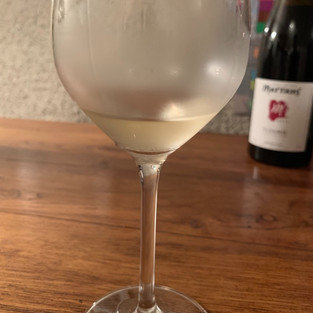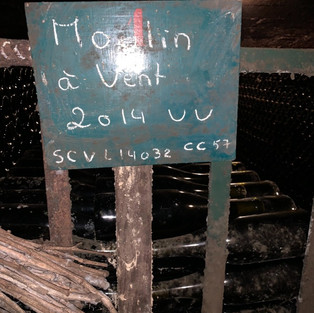North Beaujolais: Moulin a Vent into Macon
- Paolo Mittiga

- Jun 22, 2019
- 5 min read
As we left Domain Piron very pleased by the experience, we were back on The route D68 directed to other towns in this beautiful part of France. We decided to take a detour to Beaujeu, the town where the entire region gets its name.
It is a very small medieval hamlet ( what else ) where everything is dedicated to the wine of the region. Of course we tried to have some food to the local brasserie without any
success. The heat wave was strong and at 3Pm the sun had not intention to give us any break. After walking around for 15-20 minutes through the little town completely immersed in the mountains we decide it was time to head towards Moulin a Vent. But as we approached Fleurie we notice another opened winery and we drove right through the gate. Another car followed us, increasing our hope to taste other good Beaujolais.
Domain des Marrans
Domain des Marrans it is a small producer of many of the Beaujolais wines in the region. As we arrived the people from the car that followed us in the winery were looking to get into the Cellar; an older woman welcomed us and with her very broken English told us that yes a tasting was possible but we needed her son ( George) to be able to do that. As we met him we realized that we were supposed to have an appointment and he was expecting the other two gentleman that were by the cellar.
Nevertheless he was nice to ask us to join them down the cellar that was only accessible through a narrow stone staircase.

One of the man was a 6.9 tall and he had to bend in order to go through the narrow door. They were from Amsterdam, owners of wine distribution in the region and they loved Domain Marrans and were just there to buy few cases and drive back home.
The wines were very well structured and a pleasure to drink ( a detailed tasting notes when I will properly taste the samples I purchased). When I asked George if the extreme heat so early in the blooming season was a good thing for the vines , he said that it was just perfect because spring had been very cold and wet and the heat and dry weather was just what was needed.
We left for Moulin a Vent that was just down the road .. the beautiful day and the sun was starting to go down creating long shadows. The landscape was just beautiful and driving through those winding roads through the vineyards was a totally relaxing environment .. all we needed.
Finally just 15 minutes drive from the Domains des Marrans we approached Moulin a Vent which is not a town but rather the name of the AOC named after a Moulin from the 1500 , now a UNESCO protected site Since 1930.
This wine is from two villages: Romaneche-Thorins and Chenas.
It received AOC status in 1936.
There are 1,552 acres/628 ha of vines in production.
The soils are comprised of a soft and flaky arene (weathered feldspar, mica, quarte and other minerals) plus a decomposed pink granite rich in manganese.
Vineyards face east at altitudes between 800-1,300 ft/240-390 m above sea level.
There are 14 special climats which must achieve a minimum alcohol of 10.5% (vs. 10%) in order for their names to appear on the label. The most important are: Champ de cour, Champagne, en Morperay, la Delatte .

Moulin-à-Ventis considered the "King of Beaujolais" because it produces the most full-bodied and tannic wines of the Crus. In their youth they boast plum and cherry fruit with a hint of violet perfume. As they age, they become nuanced with dried fruits, truffle, cake spices and rose with meaty musky undertones. The wines can last up to 10 years depending on the vintage. After time, many will have a:tendency to become Pinot-Iike. Locals have a verb for this pinoter. they say the wines “pinotent”.
Why a Moulin a Vent.
It was around the second half of the 15th century that a Windmill was built to grind the grain of the surrounding population, on a promontory in the north-west of the town of Romanèche Thorins. Around 1550, judging by the examination of the important "terrier" (cadastre), half of the territory is still uncultivated or wooded. In 1819 the Mill stopped turning and underwent some modifications. It remains the symbol of the vintage Windmill. In 1856, Paul SAUZET took over the succession of Baroness A. Reynolds at the head of the Estate's operation between the Thorins and the Windmill. Classified as a historical monument by a 1930 decree, the MOULIN-A-VENT has been the exclusive private property of the SAUZET family for more than a hundred and fifty years. It is the flagship of the appellation.
Chateau Portier
We visited the Chateau Portier which is part of this very influent family.
As we were late to our appointment we had to wait for other clients to end their tasting, but this gave us the opportunity to enjoy the outside with the perfect Landscape. From there the view of the Moulin was just magnificent , few hundreds feet away.

We finally had the opportunity to visit the cellar and taste the wines that were a true representation of the AOC. The vines were flowering , soon to set the fruits that will ripe into perfect grapes.
Denis CHASTEL-SAUZET's vineyard... The vineyards of Domaine du Moulin à Vent and Château Portier, owned by the CHASTEL-SAUZET family, are scattered over the most famous terroirs in Moulin à Vent, Fleurie, Chénas and Chiroubles. They cover an area of 22 hectares.
Their exhibitions are among the best: South, South-East.
Château Portier, previously owned by the GAIDON family, was taken over by Denis CHASTELSAUZET in 2006. This famous castle, located a few meters from the Moulin à Vent, is a bourgeois mansion built in 1879 in the extension of the buildings of the 16th and 17th centuries. It is like the castles of Beaujolais:
Wall wall,
Terraces of shady plane trees,
Small terrace for the evening' get together ,
Burgundy towers of glazed tiles,
Beautiful reception pieces: voluptuous, richly decorated with stuff.
Denis was extremely passionate in telling all the history of the land and the chateau and to take us in the cellar that was a limestone based cave with many bottles aging in a perfect environment.
As always I will write an in depth tasting notes of the excellent wines we tasted.
Finally as the sun was starting its descend, we drove towards Macon and the Maconnaise the entry to Burgundy , or Bourgogne as the French of course prefer to be called.
To the next blog as we continue our Journey through the Holy Land of wine.












































































































Comments